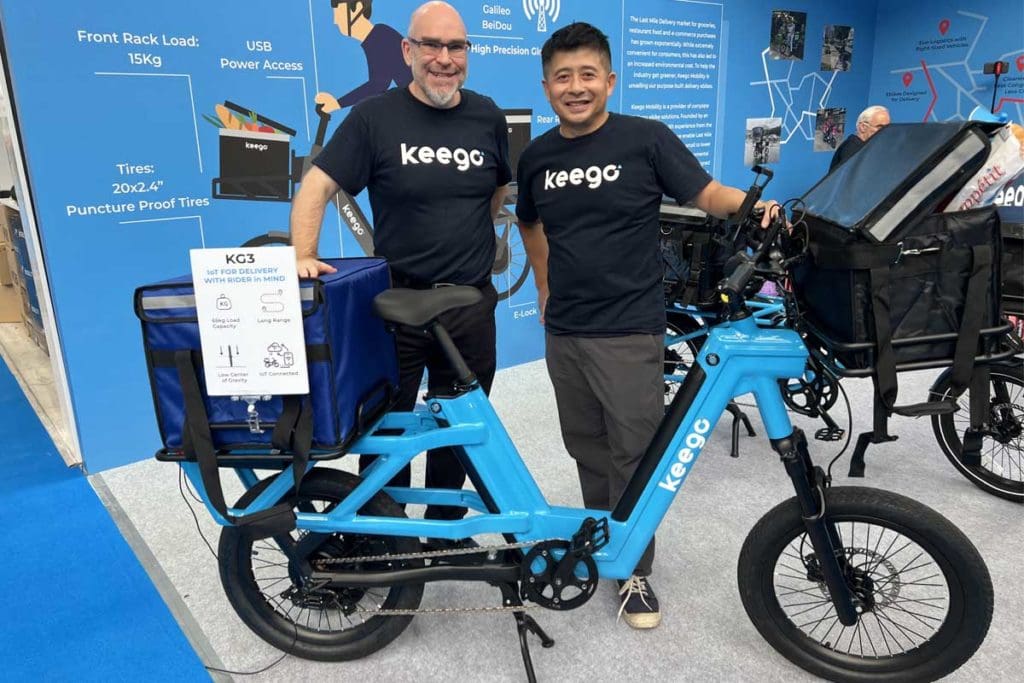Commercial Cargo Requirements Define a New Category

Frankfurt, Germany
The entire cargo bike market is still in its infancy in Australia. But shows like Eurobike give us a glimpse into what the future holds.
The European cargo market has already reached 500,000 units per year. Given the high unit price of each bike, particularly as most of them are electric, that would equal an annual market already worth A$3 billion at retail prices, assuming an average unit value of $6,000.
Not surprisingly, with such rapid growth and already a substantial market, investment into new technologies and models is pouring in.
The market is also splitting into three distinct segments: ‘Traditional’ full-size cargo bikes that are usually front loading, ‘compact cargo’, usually with 20-inch wheels, rear loading and a smaller overall size, and finally ‘commercial cargo’, where every aspect of the bike is designed and built with commercial delivery considerations in mind.
Keego is an interesting example of this third category, commercial cargo
We spoke to two of the three co-founder, Elias Ek and Bob Tsai.
“Our KG 4 is a long-tail bike which comes standard with one battery but you can have two batteries, which will give you a range of about 120 kilometres, depending upon how heavy you are, how much you’re pedalling and so on,” said Elias.
“The testing we’ve done with delivery drivers shows that most of them are doing 80 to 90 kilometres per day in a long shift, so they should be able to get a full day’s work from one charge.
“Our top speed varies on the legal basis of each country – it could be 25 kph or 32 kph.
“It comes in a seven-speed option but we’re pushing the single speed version. The companies we’re talking to are looking for as much simplicity as possible. We can put 50kg in the back, 15kg in the front.”
Elias thinks the market for higher-quality cargo bikes will grow as the market matures.
“Right now, most companies don’t own many bikes but consumer bikes are not built for working 8-10 hours per day,” he said, referring to the ‘gig economy’ model in which the delivery rider owns or leases their own bike, often of low price and inferior quality.
“However, there are three big trends that are pushing companies towards what we’re offering in terms of a more cohesive fleet,” Elias predicted.
“The first is the legality of the ‘gig work’ model. More and more countries are not accepting this type of workforce.
“I have another company (in marketing) with 50 people working there and I sure as hell can’t get away without paying their labour insurance and things like that, so why should they?
“If they have to hire their own employees, then suddenly they start caring about what quality of bikes they’re riding. Are they safe? Are they optimised for getting from point A to B?
“The second factor is competition. Now when you have so many companies promising 10 to 15-minute grocery delivery. As soon as the customer hits ‘send’ on that order, somebody is picking groceries as fast as they can. They can’t rely that there might be a ‘gig rider’ that just might be standing nearby when each order comes in. They need to have their own riders ready to go.
“The third one, also relating to competition, is that this bike is a nice advertising billboard. You paint it up in your company colours and logos. At volume, we’re happy to paint it in any colours and put any logo on there.
“Because it’s a bicycle, not a motorcycle, you can ride places that motorcycles can’t. You’re also more likely to be able to park where motorcycles can’t.
“Having the highest top speed is a fallacy. The key point is total delivery time from A to B.
“The anti-theft part is super-important in many cities, so we’re working with a couple of different smart lock manufacturers. You can just stop, walk away, the lock will lock itself as soon as either your smart key fob or mobile phone is beyond a certain distance from the bike. As soon as you walk back, it unlocks again.”
Bob, who has been working on product development for three years, then spoke about Keego’s new KG3 model, which was being launched at Eurobike in prototype format, with production models on sale from December 2022.
“All aspects of the KG3 were designed for delivery riders,” Bob explained. “Step-through design for easy mount and dismount. Smaller wheels for lower centre of gravity. Front suspension for rider comfort. Dual batteries for maximum range. 50kg rear and 20kg carrying ability for ample capacity. Internal cable routing to minimise environmental exposure and vandalism, quick release seat post, puncture resistant tyres … This thing is built like a tank! It’s built to last.
“It’s also a smart bike. You can track where your rider is, how much battery is remaining, how many kilometres each rider has done.
The question we ask ourselves is: “How do we help the rider stay on the road to do as many deliveries as possible?”
Keego bikes are likely to be available in Australia soon, but at the time of writing, a distributor had not been announced.
